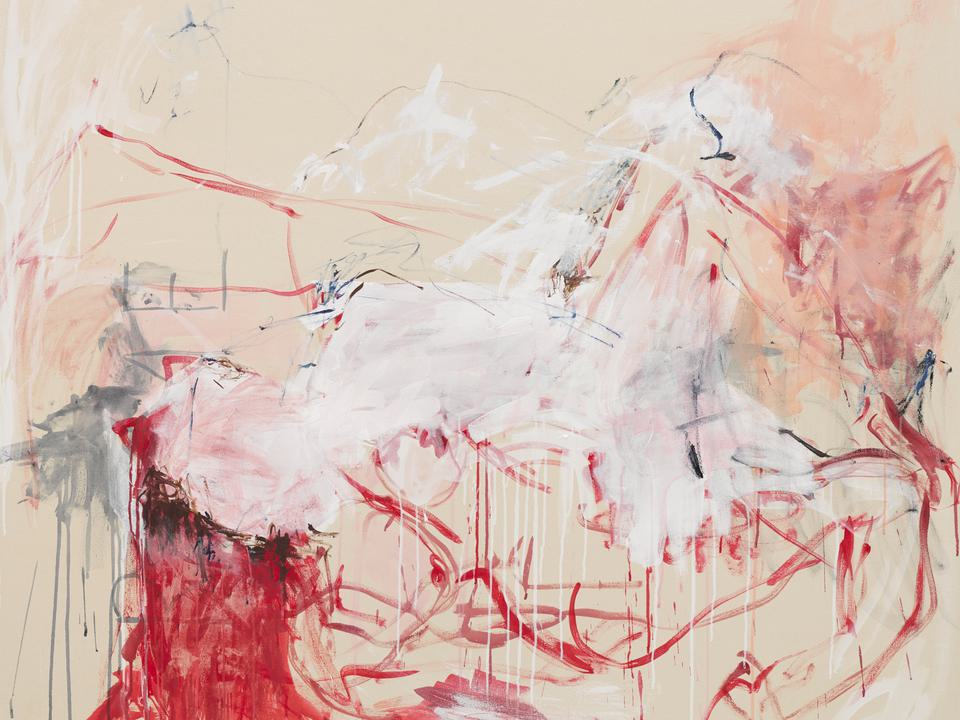
A Fortnight of Tears
Tracey Emin
A Fortnight of Tears
6 February – 7 April 2019
Dates
6 February – 7 April 2019
[Emin’s] sculptures of women in states of rapture and longing are open and unconcealed confessions of fantasy, desire, passion. They are visions of the earth-shaking love she still believes in.
On entering South Gallery I, the viewer is confronted by fifty double-hung self portraits from an on-going series taken at different moments and states during the artist’s periods of insomnia. These unsettling and intimate close-ups, blown up in size and overwhelming in number, capture the habitual torment and desperation of these lonely wakeful hours.
In her new paintings shown throughout the exhibition, Emin articulates the joy and suffering that is intrinsic to human existence, from the often fraught territory of sexual relationships, to the physical trauma of abortion, and the recent passing of her mother. There is an uninhibited energy to these new works, as she powerfully inscribes emotional turmoil through a freer yet assertive form of gestural figuration. Focusing on her own body as a conduit for her feelings, she connects with a history of expressive figuration in art, from the moving realism of Käthe Kollwitz to the modernist angst of Edvard Munch or the heightened sexuality of Egon Schiele’s female subjects.
Emin employs a palette of visceral pink and dark red tones in many of the works, creating a heightened physicality that alludes to the degenerative journey between birth and death. Drips and bleeding paint point to the fluidity of the body and figures are ghostly, bereft of any recognisable details of context or place. In I watched you disappear. Pink Ghost (2018), for example, a spectral presence appears to be dissolving, insubstantial and elusive. Several other highly gestural figures, such as But you never wanted me (2018), or It was all too Much (2018), convey feelings of love and desire, while others bluntly depict the acts of sexual aggression that continue to haunt the artist.
‘A Fortnight of Tears’ centres around Emin’s own pain, including her mother’s death, with works shown in The Ashes Room evoking states of bereavement, mourning and enduring love. Set against the melancholic grey tone of the walls, I Could Feel You (2018), Bye Bye Mum (2018), I Prayed (2017) and Can you hear me (2017) all depict grief with absolute candour. In I was too young to be carrying your Ashes (2017–18) the sheer sorrow contained in the figure clutching a box is conveyed through broad brushstrokes that turn from vivid red to black.
In a new film screened alongside these paintings, the camera pans slowly across a table towards a wooden box placed at one end, bathed in an ethereal light. Emin recalls the overwhelming weight of her mother’s ashes as she carried them back to her home: ‘I carried her ashes across the street – trying not to cry, trying not to think. It somehow felt wrong like I was stealing something – like I was a thief’.
The celebration of motherhood and the female form reappears in The Mother (2017) installed in the 9 × 9 × 9 gallery. This bronze sculpture relates to Emin’s public commission for Oslo’s Museum Island, which will be permanently installed beside the Edvard Munch Museum from late spring 2020. A kneeling nude, gazing intently upon an absent form cradled in her palms, she is a profound symbol of femininity and refuge. Two further sculptures portray a female figure lying face down or curled up in vulnerable and eroticised poses, with delicately modelled limbs elongated, hands clenched by her head or between her legs. As Jonathan Jones writes: ‘[Emin’s] sculptures of women in states of rapture and longing are open and unconcealed confessions of fantasy, desire, passion. They are visions of the earth-shaking love she still believes in.’
Exhibited alongside the paintings, film and drawings are four vitrines containing intimate works on paper, maquettes and memorabilia curated from the artist’s archive, which are organised thematically, based on the subjects of love, sex, death and fear.
The endnote to the exhibition is How It Feels (1996), a pivotal early film in Emin’s career. Here the artist, seen walking through the streets of London, recounts the ordeal of her first abortion in 1990 and how through that crisis she came to the revelation that art could not be made for art’s sake it had to be intrinsically bound up with her own life. As she described it: ‘the essence of creativity, that moment of conception… the whole being of everything... it had to be about where it was really coming from’.

Tracey Emin
Visit Artist PageCreate an Account
To view available artworks and access prices.












